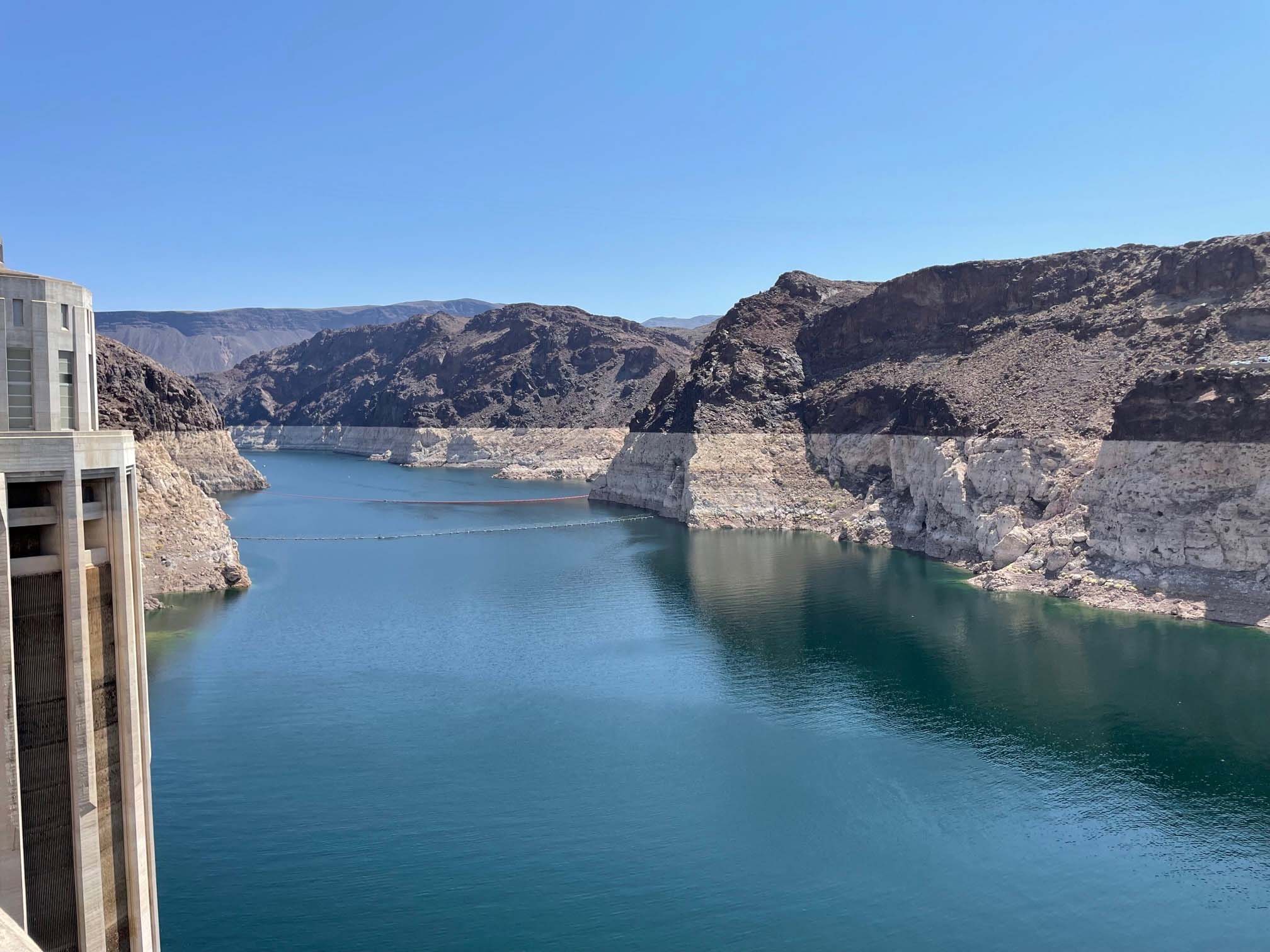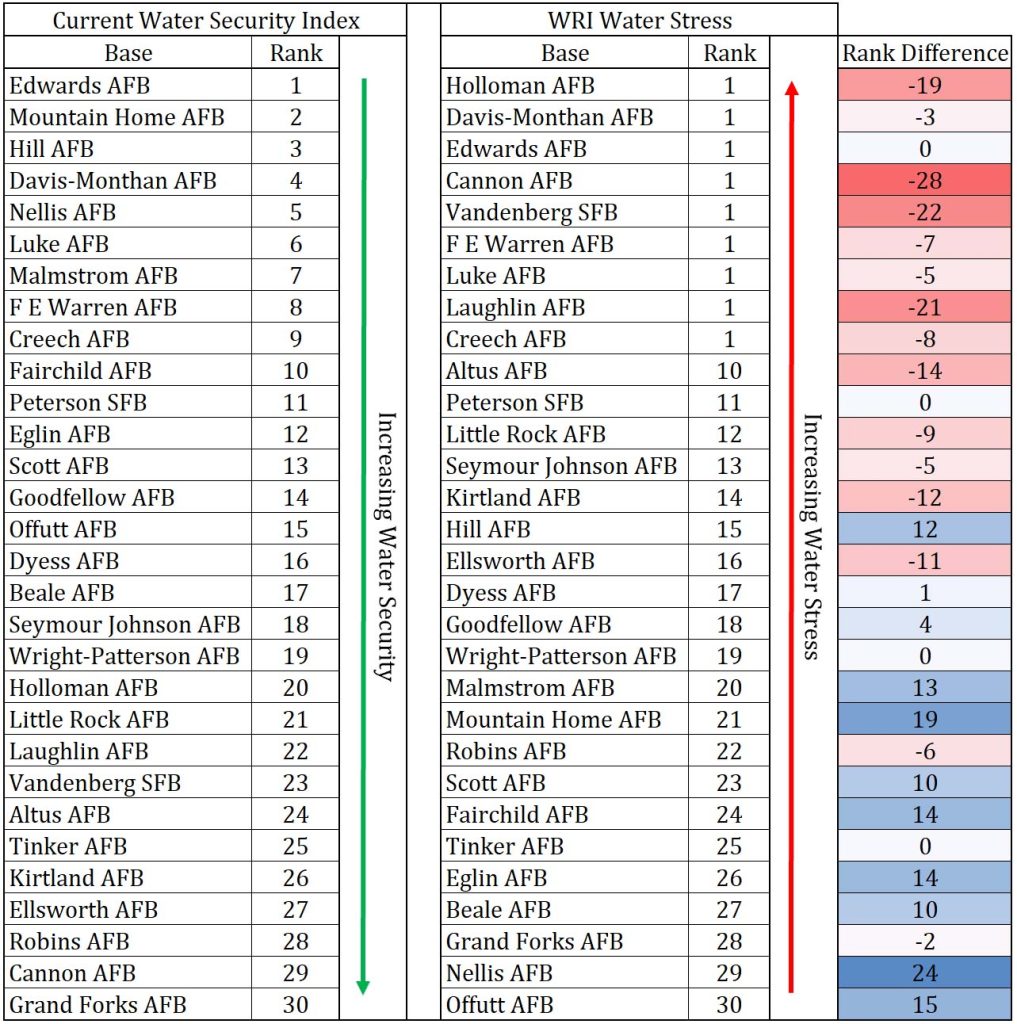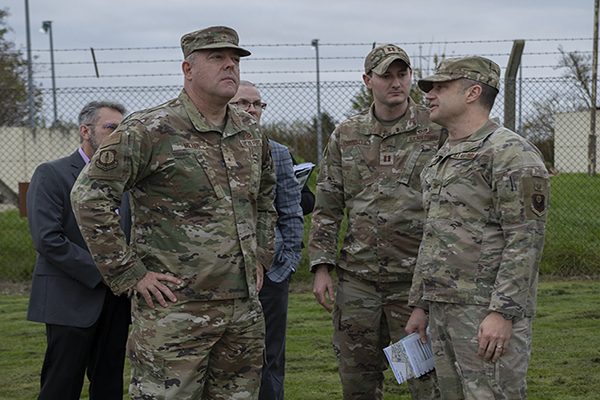By 1st Lt. Michael Berg, USAF, Lt. Col. Daniel Weeks, Ph.D., P.E., M.SAME, USAF, and Christopher Chini, Ph.D.
A recent study that evaluated the current and future relative water security risk of 30 installations across the Department of the Air Force offers a quantitative metric that can prioritize and support resiliency investments across the enterprise.

the water security risks they face from evolving climate conditions. Photo courtesy Christopher Chini, Ph.D.
Mountain Home AFB, located in southwestern Idaho, faced a water scarcity concern due to the diversion of water from a critical declining aquifer. This challenge spurred an enterprise-wide assessment of overall installation water security risk, an undertaking that was then codified by the inclusion of base water security and management in the National Defense Authorization Act.
Similar assessments are common in academia. However, they typically focus on city-level or basin-level evaluations and are rarely applied to a large number of noncontiguous locations that span diverse climates, as does the U.S. military’s installation portfolio.
A study recently conducted by the Air Force Institute of Technology (AFIT) built a framework for enhancing common indicator-based methods to calculate the current and future relative water security at 30 installations across the continental United States, including both U.S. Air Force and U.S. Space Force locations. The analysis used 14 indicators that spanned climate, demand, and infrastructure categories obtained from the Air Force Civil Engineer Water Dashboard and other open-source data sets.
Indicator Selection
The research team, following an academic literature review, settled on the 14 indicators. These then were grouped into a series of broader categories that allowed for coordinated analysis.
- Climate (water quality, drought, evapotranspiration, precipitation, runoff)
- Demand (serviced population, population change, demand/supply ratio, outdoor water use)
- Infrastructure (loss rates, drinking water storage, system size, outage duration, groundwater table decline or surface water depletion)
The AFIT study compiled and normalized indicators using utility functions on a scale of 0 representing low water security and 100 representing high water security. Overall, half of the indicators were obtained from the Air Force Civil Engineer Water Dashboard. The remainder were open source.
Locations Assessed. A total of 30 installations were selected for the assessment. The priority was to evaluate bases in the western half of the country, though several eastern installations were included to ensure the relative nature of the final metric. Experts with a background in water resources from the Air Force and the U.S. Army were solicited for their input to compare the importance of water security indicators and categories under current and future climate conditions. These responses were then tabulated and used within a two-stage analytical hierarchy process (AHP).
AHP is a multi-criteria decision-making tool that can aid in determining the relative importance of components within complex problems. A two-stage AHP, for instance, reduces the total number of comparisons needed by grouping components or indicators, determining the weight of indicators within each group, and comparing the relative importance of the groups.
Under current conditions, climate, demand, and infrastructure accounted for 30 percent, 37 percent, and 33 percent of the overall scores, respectively. These weights changed significantly under future conditions based on expert responses. In those cases, climate accounted for 55 percent of the overall score, demand accounted for 18 percent, and infrastructure accounted for 27 percent. Drought, demand/supply ratio, and loss rates were the most heavily weighted indicators of each category.
Calculating Security
Coupling the weights derived from the AHP with the normalized indicator data allowed for current and future water security scores and rankings to be calculated. For the current water security risk metric, the 10 installations that showed the lowest level of water security were largely in the western half of the United States. Higher water security installations were generally located east of the Mississippi River. The ordering of installations did not change substantially whether comparing current or future conditions.
Evaluating Stress Levels. The evaluation methods for water vulnerability and security at Air Force installations utilize a water stress and overall water risk metric established by the World Resources Institute (WRI). This tool is a global gauge that evaluates water stress at the basin level. As part of the AFIT study, the research team compared its relative rankings to those of WRI.
Assuming that water stress and water security have an inverse relationship, in that high levels of water stress would correspond to low water security, the researchers found major discrepancies between the currently employed WRI metric and the local data for the installations from the AFIT study. Several locations had high calculated water security in the AFIT study, yet reported high water stress according to WRI. These include Holloman AFB, N.M., Vandenberg SFB, Calif., and Cannon AFB, Ariz. Conversely, both Mountain Home AFB and Nellis AFB, Nev., which are known to be at risk of water security, were ranked among the lowest five bases in current water security in the metric developed by AFIT, but categorized by WRI as low water stress.
The contrasting results of the research highlight the importance of leveraging existing local data to make informed water security decisions. Global metrics that do not consider the nuances of local conditions are problematic for effective decision-making.

Prioritizing Projects
The AFIT study provides a quantitative metric to support water security investments (in line with the requirements of Section 2827, National Defense Authorization Act, and climate-informed decision-making prescribed under the DOD Climate Adaptation Plan).
Assessments under Section 2827 are prioritized for installations that are experiencing the greatest risks to sustainable water management and security, while also confronting the most severe existing or potential adverse impacts to mission assurance. The current and future relative water security could serve as justification for installation prioritization for evaluations under expanded water management and security assessments.
Recommended Actions
Based on the results of the AFIT study, it is recommended that the Defense Department generate its own portfolio of water security indicators to evaluate where to invest for water security on a more holistic scale. Additionally, future iterations of this work should likely include climate forecasted data, which can be signals for surface water vulnerability.
The methods used in the study demonstrate the importance of local climate and water data from installations in water security assessments. Leveraging the data available from both the Air Force Civil Engineer Water Dashboard and open sources allows for characterization of impacts to water security. Similar methods could be used to characterize other climate threats, complementing resources like the Defense Climate Assessment Tool.
1st Lt. Michael Berg, USAF, is Graduate Student, and Lt. Col. Daniel Weeks, Ph.D., P.E., M.SAME, USAF, is Assistant Professor, Department of Systems Engineering & Management, Air Force Institute of Technology. They can be reached at michael.berg.17@us.af.mil; and aniel.weeks.2@us.af.mil.
Christopher Chini, Ph.D., is Earth Scientist, Earth Systems Predictability & Resiliency Group, Pacific Northwest National Laboratory; christopher.chini@pnnl.gov.
Article published in The Military Engineer, July-August 2024
More News from TME
-

Leading the Way: Partnering for Resiliency and Readiness
TME Interview with Brig. Gen. Patrick Miller, P.E., F.SAME, USAF Commander, Air Force Civil Engineer Center -

Developing Tomorrow’s STEM Workforce Through Partnership
TME recently interviewed leaders of the Panama City Post about paying it forward, their repertoire of STEM outreach, and the benefits of collaborating with similar-minded professional organizations. -

Electrifying Solutions for Military Installations
As military installations implement electrification measures into the future, the challenges they face will not just require innovative technology solutions but embracing a holistic delivery approach implemented early in projects.